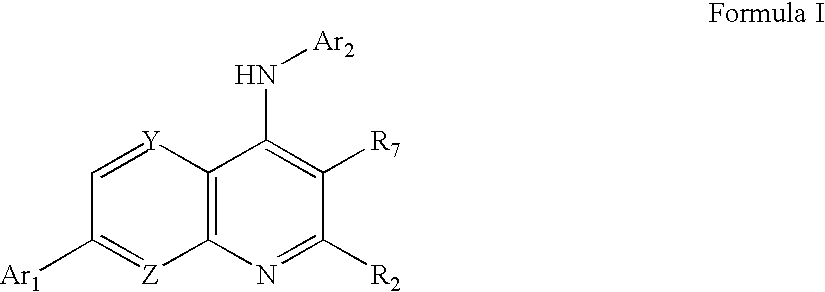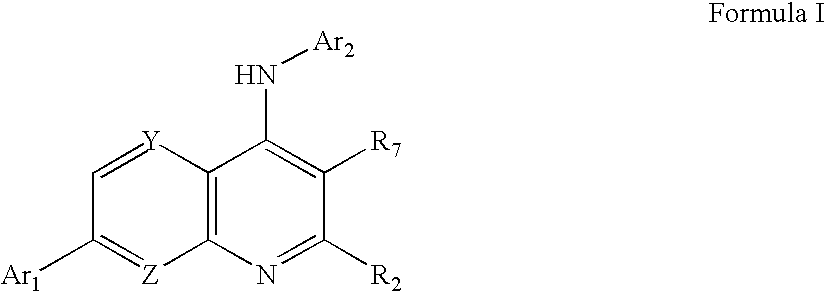Heteroaryl Substituted Quinolin-4-Ylamine Analogues
a technology of quinolin-4-ylamine and heteroaryl, which is applied in the field of heteroaryl substituted quinolin-4-ylamine analogues, can solve the problems of more debilitating, acute or chronic pain, and damage to the nervous system, and achieves the effects of reducing the calcium conductance of a cellular capsaicin receptor, promoting weight loss, and inhibiting the binding of vanilloid ligands
- Summary
- Abstract
- Description
- Claims
- Application Information
AI Technical Summary
Benefits of technology
Problems solved by technology
Method used
Image
Examples
example 1
Preparation of Representative 5-Membered Heteroaryl Substituents
[0176] This Example illustrates the preparation of representative 5-membered rings for use in preparing heteroaryl substituted quinolin-4-ylamine analogues.
A. 1-[5-(Trifluoromethyl)-1,3-thiazol-4-yl]ethanone
[0177]
1. Ethyl 2-amino-5-iodo-1,3-thiazole-4-carboxylate
[0178]
[0179] Dissolve ethyl 2-amino-1,3-thiazole-4-carboxylate (5.00 g, 29.0 mmol) in DMF (40 mL) and add N-iodosuccinimide (7.18 g, 31.9 mmol). Heat the mixture at 60° C. overnight. Cool the mixture and add EtOAc (300 mL). Extract with 1N NaOH (200 mL), H2O (2×200 mL) and brine (1×200 mL). Dry the organic layer over Na2SO4 and evaporate under reduced pressure. Purify the crude product by chromatography on silica gel eluting with EtOAc / hexanes (2:1) to yield the title compound. LC / MS (MH+) 298.98.
2. Ethyl 5-iodo-1,3-thiazole-4-carboxylate
[0180]
[0181] Dissolve ethyl 2-amino-5-iodo-1,3-thiazole-4-carboxylate (3.53 g, 11.8 mmol) in dry THF (60 mL). Heat the s...
example 2
Preparation of Representative Heteroaryl Substituted Quinolin-4-ylamine Analogues
[0197] This Example illustrates the preparation of representative heteroaryl substituted quinolin-4-ylamine analogues.
A. N-[5-(Trifluoromethyl)pyridin-2-yl]-7-[5-(trifluoromethyl)-1,3-thiazol-4-yl]-1,8-naphthyridin-4-amine (Compound 1)
1. tert-Butyl 4-chloropyridin-2-ylcarbamate
[0198]
[0199] Dissolve azido(4-chloropyridin-2-yl)methanone (1.5 g, 0.008216 moles, prepared essentially as described by Sundberg and Jiang (1997) Org. Prep. Proced Int. 29:117-122) in toluene (20.0 mL) and heat at 55° C. for 2 hours. Add t-butanol (1.96 mL, 0.02054 moles) to the reaction mixture and continue heating at 80° C. for 24 hours. Cool the mixture and concentrate under reduced pressure to afford a residue. Dissolve the residue in EtOAc / 1.0 N aq. NaOH (50.0 mL each). Separate the organic layer, extract the aqueous solution with EtOAc (3×20.0 mL), wash the EtOAc with brine, dry (MgSO4) and concentrate under reduced pres...
example 3
Additional Representative Heteroaryl Substituted Quinolin-4-ylamine Analogues
[0214] Using routine modifications, the starting materials may be varied and additional steps employed to produce other compounds provided herein. Compounds listed in Tables I and II are prepared using such methods. All compounds listed in Table I have an EC50 that is less than 1 micromolar in the assay provided in Example 6. LC / MS retention times are given in minutes.
TABLE IRepresentative Heteroaryl Substituted Quinolin-4-ylamine AnaloguesRet.LC / MSCompoundNameTimeM + H1H NMR37-(4-methyl-1,2,5- oxadiazol-3-yl)-N-[5- (trifluoromethyl)pyridin- 2-yl]-1,8-naphthyridin-4- amine1.22373.09(CDCl3) δ 9.09 (d, 1H), 8.66 (s, 1H), 8.58 (d, 1H), 8.32 (d, 1H), 8.14 (d, 1H), 7.91 (d, 1H), 7.78 (br s, 1H), 7.21 (d, 1H).47-(2,4-dimethyl-1,3- thiazol-5-yl)-N-[5- (trifluoromethyl)pyridin- 2-yl]-1,8-naphthyridin-4- amine1.22402.07(CD3OD) δ 8.92 (br m, 2H), 8.63 (s, 1H), 8.48 (br s, 1H), 8.01 (dd, 1H), 7.83 (d, 1H), 7.39 (d,...
PUM
| Property | Measurement | Unit |
|---|---|---|
| temperatures | aaaaa | aaaaa |
| time | aaaaa | aaaaa |
| temperature | aaaaa | aaaaa |
Abstract
Description
Claims
Application Information
 Login to View More
Login to View More - R&D
- Intellectual Property
- Life Sciences
- Materials
- Tech Scout
- Unparalleled Data Quality
- Higher Quality Content
- 60% Fewer Hallucinations
Browse by: Latest US Patents, China's latest patents, Technical Efficacy Thesaurus, Application Domain, Technology Topic, Popular Technical Reports.
© 2025 PatSnap. All rights reserved.Legal|Privacy policy|Modern Slavery Act Transparency Statement|Sitemap|About US| Contact US: help@patsnap.com



